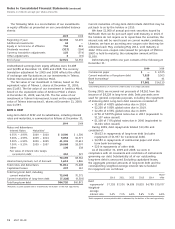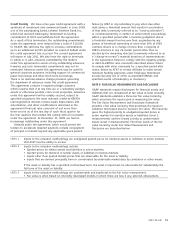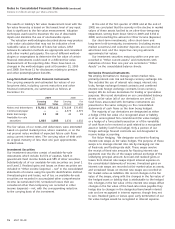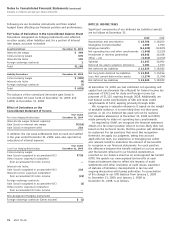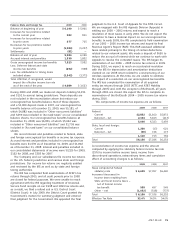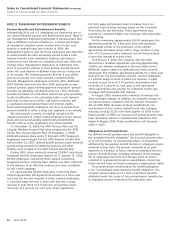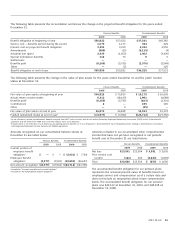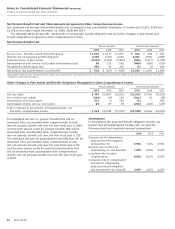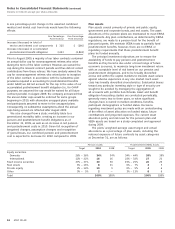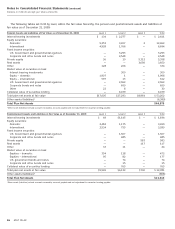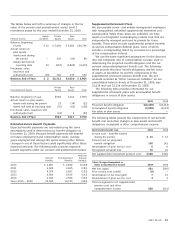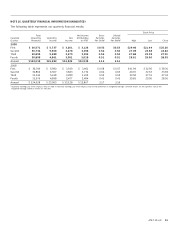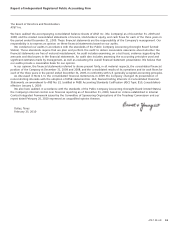AT&T Wireless 2009 Annual Report Download - page 86
Download and view the complete annual report
Please find page 86 of the 2009 AT&T Wireless annual report below. You can navigate through the pages in the report by either clicking on the pages listed below, or by using the keyword search tool below to find specific information within the annual report.
Notes to Consolidated Financial Statements (continued)
Dollars in millions except per share amounts
84 AT&T 09 AR
Plan Assets
Plan assets consist primarily of private and public equity,
government and corporate bonds, and real assets. The asset
allocations of the pension plans are maintained to meet ERISA
requirements. Any plan contributions, as determined by ERISA
regulations, are made to a pension trust for the benefit of
plan participants. We maintain VEBA trusts to partially fund
postretirement benefits; however, there are no ERISA or
regulatory requirements that these postretirement benefit
plans be funded annually.
The principal investment objectives are to ensure the
availability of funds to pay pension and postretirement
benefits as they become due under a broad range of future
economic scenarios, to maximize long-term investment return
with an acceptable level of risk based on our pension and
postretirement obligations, and to be broadly diversified
across and within the capital markets to insulate asset values
against adverse experience in any one market. Each asset
class has broadly diversified characteristics. Substantial biases
toward any particular investing style or type of security are
sought to be avoided by managing the aggregation of
all accounts with portfolio benchmarks. Asset and benefit
obligation forecasting studies are conducted periodically,
generally every two to three years, or when significant
changes have occurred in market conditions, benefits,
participant demographics or funded status. Decisions
regarding investment policy are made with an understanding
of the effect of asset allocation on funded status, future
contributions and projected expenses. The current asset
allocation policy and risk level for the pension plan and
VEBA assets are based on a study completed and approved
during 2009.
The plans’ weighted-average asset target and actual
allocations as a percentage of plan assets, including the
notional exposure of future contracts by asset categories
at December 31, are as follows:
A one percentage-point change in the assumed combined
medical and dental cost trend rate would have the following
effects:
One Percentage- One Percentage-
Point Increase Point Decrease
Increase (decrease) in total of
service and interest cost components $ 325 $ (266)
Increase (decrease) in accumulated
postretirement benefit obligation 3,423 (2,842)
Prior to August 2009, a majority of our labor contracts contained
an annual dollar cap for nonmanagement retirees who retire
during the term of the labor contract. However, we waived the
cap during the relevant contract periods and thus did not collect
contributions from those retirees. We have similarly waived the
cap for nonmanagement retirees who retired prior to inception
of the labor contract. In accordance with the substantive plan
provisions required in accounting for postretirement benefits
under GAAP, we did not account for the cap in the value of our
accumulated postretirement benefit obligation (i.e., for GAAP
purposes, we assumed the cap would be waived for all future
contract periods). In August 2009, the company announced that
the annual dollar caps would be enforced for some groups
beginning in 2010, with alternative uncapped plans available
and participants assumed to move to the uncapped plans.
Consequently, no substantive assumptions about the annual
caps being waived are reflected after August 2009.
We also changed from a static mortality table to a
generational mortality table, creating an increase in our
pension and postretirement benefit obligations as of
December 31, 2009, as well as an increase in net pension
and postretirement costs in 2010. Given full recognition of
bargained changes, assumption changes and recognition
of gains/losses, our combined pension and postretirement
cost is expected to decrease for 2010 compared to 2009.
Pension Assets Postretirement (VEBA) Assets
Target 2009 2008 Target 2009 2008
Equity securities:
Domestic 26% – 36% 34% 34% 34% – 44% 39% 39%
International 12% – 22% 16 16 22% – 32% 27 21
Fixed income securities 27% – 37% 30 30 15% – 25% 20 25
Real assets 6% – 16% 8 11 0% – 7% 2 3
Private equity 4% – 14% 10 9 0% – 9% 4 6
Other 0% – 5% 2 — 3% – 13% 8 6
Total 100% 100% 100% 100%


